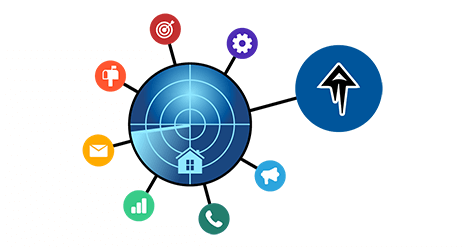5 Ways To Generate Solar Leads That Become Solar Sales
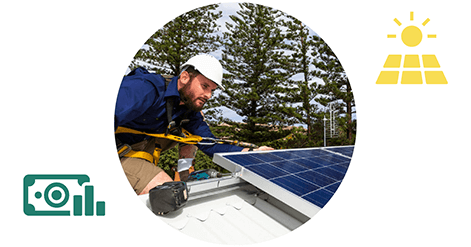
** Updated for 2023**
It’s 2023. If you’re still trying to drum up solar leads by saturating zip codes with mailers, having your sales reps indiscriminately knock on doors and blindly cold call, you’re wasting precious time and money.
Poorly planned prospecting & marketing efforts like this lead to terrible response rates and burnt out sales reps (that churn). Not to mention you run the risk of damaging your brand.
So the question is, what exactly sets successful solar installers apart from unsuccessful ones in 2023?
One four-letter word: data.
Successful solar installers use data to find and qualify solar leads before engagement to ensure that every knock, every call, every mailer, every text & email has a higher probability of turning into a solar sale than it does a dead-end.
This smart use of data is especially pivotal right at the beginning of the sales cycle: tracking down solar leads. In-depth property information is essential to create a high-quality lead list; the right property data tool not only does that but also helps your sales team nurture their solar leads with automated, data-driven marketing all the way to the sale.
Using data to be strategic and surgical in your prospecting and marketing efforts like this is a solar sales game changer.
In this post we're going to cover:
- 5 ways to generate solar leads
- [Video] How to find solar leads with PropertyRadar
- Qualifying solar leads based on your criteria
- Creating lists of targeted solar leads
- Reviewing owner details & contact info
- Reviewing property, mortgage, and equity details
- 4 ways to turn solar leads into solar sales with PropertyRadar
-
Generating Solar Leads for the Data-Driven Business with PropertyRadar
5 Ways to Generate Solar Leads
1. 3rd Party Websites
Familiar to both solar professionals and their prospects, these SEO-dominating websites provide solar-curious homeowners with quotes from (and reviews about) multiple local installers. The main players here include EnergySage, SolarReviews, and CleanEnergy Experts (owned by SunRun).
- Pros: If you’re a homeowner interested in solar, you’ll almost definitely Google some solar-related phrase that leads you to these three giant third-party websites. They’re by far the biggest source of organic leads for solar installers.
- Cons: These leads are usually anything but exclusive: your prospects will get quotes from your competitors right along with yours. The quality of leads varies highly, from “solar panels happened to cross my mind one day” to “let’s install yesterday.” Finally, even these behemoths only drum up a few hundred organic leads per day -- across the entire U.S.
- Best For: Your local area’s solar market saturation determines whether these marketplaces are worth their pay-to-play price. If you’re in a relatively unsaturated locale, these leads will probably be more valuable to you since it’s less likely that your competition will snatch them up before you have a chance.
- Type: Passive. You aren’t in control of finding these leads; you just sit back and wait for the third-party website to reach out to you with each lead.
Looking For Solar Leads?
|
2. Inbound Marketing
A robust inbound sales process attracts leads to your business like bees to honey. A reader-friendly online presence provides such value to curious homeowners that when they do decide to get a solar quote, you’ll be the first brand they think of.
This online presence usually consists of
- active social media accounts (Facebook, Twitter, and/or Instagram)
- paid Google advertisements
- A managed Google Review page
- A professionally designed website with frequent updates
- Pros: Inbound marketing is by far the least expensive cost per lead. It results in an average of 54% more leads than traditional paid marketing, while saving businesses roughly $20K per year. If your website and social media dominate local SEO with frequent insightful content (meaning that it educates homeowners on the ins and outs of going solar in your area), local leads will see and respond to your professionalism.
- Cons: Inbound marketing is not for the impatient or easily distracted. Even the best digital marketing strategies can take 2-3 years before you’ll start seeing significant results.
- Best For: The long game. Don’t expect results soon...but with such relatively low investment and high return, there’s no reason not to develop a strong digital presence that will bring in more and more sales over time.
- Type: Passive. As with third-party websites above, leads reach out to you; you aren’t in control of reaching out to them proactively.
3. Referrals
It goes without saying that referrals can be your best form of solar leads - they come to you mostly pre-qualified. The challenge for many SMBs however is building a system and network. But once established, referrals that come your way are like money in the bank.
- Pros: Nothing builds trust as much as one of your friends enthusing about a local business’s professionalism, integrity, and skill. Especially with major purchases like solar panels, 83% of buyers consider the most trustworthy sources to be referrals from people they know.
- Cons: This isn’t a quick-fix solution. Like inbound marketing, it takes time and ongoing dedication to start and keep the ball of referrals rolling.
- Best For: Motivated solar teams who are willing to spend time building an effective system. Look through these six solar referral strategies from Aurora to find a blueprint for an ongoing referral machine.
- Type: Passive. In the end, it’s up to the customer whether they want to share your information with their friends or not.
4. Solar Lead Lists
You’ve almost certainly bought a solar lead list, and probably far more than one. This solar industry standby is one of the most common ways solar installers find leads.
- Pros: While playing the long game of inbound marketing and referrals, businesses need income here and now! Buying leads, the first proactive option on this list, brings them in quickly and easily -- if not always cheaply.
- Cons: As every solar installer knows, the quantity of leads in a list does not equal quality! While you can buy cheap solar leads, they’re often non-exclusive (meaning other installers also have their information) and outdated. By the time your sales team contacts them, it’s likely another installer has beaten you to the sale. And that’s assuming their contact information is even up-to-date -- which isn’t always the case for cheap leads.
- Exclusive current leads are a much more reliable source of business. This means they’re also more expensive, but worth the cost -- your sales team will hear far more interest and far fewer crickets.
- Best For: Companies who need business in the short term and can invest in high-quality, exclusive lists.
- Type: Active. While you mostly have control over the lists you buy, what you don't have is control over the quality of data that supplies those lists. And you definitely don't have control over who else can and already has) bought and used those lists.
5. Property Data & Owner Info Platform
If you’re a motivated solar installer, you don’t want to rely purely on passive lead generation methods like the first three in this list. While these certainly have their place in a well-developed sales strategy, depending on every single lead to contact you first is a recipe for snail-slow business.
But on the other hand, neither do you want to overspend on lead lists – especially if they’re not as well-qualified as their lead companies claim.
Fortunately, there’s a new and proven tech solution on the block.
For the last decade, property data software tools have made it easy for solar professionals to create, qualify, and contact their own unique lead lists using publicly available data. With a data platform like PropertyRadar, you can sift through prospects in any location of your choice according to income, equity level, roof type, and nearly any other filter (or combination of filters) a solar installer could desire. Add in a quick preliminary search for sun-exposed roofs on Google’s Project Sunroof and you have yourself the key to building solar lead lists as highly targeted as you desire. (See the below section for a step-by-step tutorial.)
Pros:
- This method gives you much more control and real-time information than buying someone else’s(possibly outdated) lead list. You can mix and match property data, mortgage information, and other publicly available records to create hyper-localized lead lists that are a perfect fit for your business’s unique offerings.
- Some options (such as PropertyRadar) include links to social media profiles, skip tracing, email addresses, and phone numbers.
- Many platforms are available as mobile apps with GPS functionality. This gives in-the-field team members the ability to add notes, images, and files while examining a particular building.
- Not only can you update these lead lists whenever you want -- they often auto-update themselves with new leads that fit your parameters! You can even program them to send an automatic welcome mailing, email, and/or text to newly qualified leads. We call this “set-it-and-forget-it prospecting.”
Cons:
- These platforms are not free – usually subscription-based with additional charges for specific record types like documents, emails, and phone numbers.
- Not for beginners. These platforms take time to explore and get used to the vast amount of data that’s available.
- Advanced features like integrations and automation capabilities can be intimidating. Sometimes requires 3rd party support.
Best For: Motivated installers who are serious about actively growing their business, have a solid CRM system, and are willing to invest time in team training.
Type: Active. No more waiting around for leads -- you’re out in the forest tracking them down.
Pro Insights: Now that these options have been on the market for several years, solar professionals are quickly learning that comprehensive property and owner data analysis isn’t an option anymore -- it’s a must.
Crack open the sales process of any booming solar business today, and you’ll find it begins with a comprehensive, user-friendly property data platform. This is how their teams beat competitors to the best new opportunities without wasting time and money chasing down lackluster prospects. This is what makes the difference between successful and unsuccessful businesses in the 2020’s.
How to Find Solar Leads Using PropertyRadar
We won’t ask you to just take us at our word for how powerful the right property data tool can be. So here’s a video and text breakdown of how to use PropertyRadar to quickly build the perfect solar lead list for your business. You can practice these steps using real-time data for free with PropertyRadar’s no-commitment free trial.
In response to a solar installer’s question of how to generate solar leads with PropertyRadar, Vice President of Marketing Insights Aaron Norris created a step-by-step video using a California community as a use case:
Step-by-Step Breakdown of Above Video
1. First, Aaron used Google Project Sunroof to find suitable buildings for solar installations in this California zip code. Already familiar to many installers, Google Sunroof identifies roofs with enough sun exposure to make solar panels worthwhile.
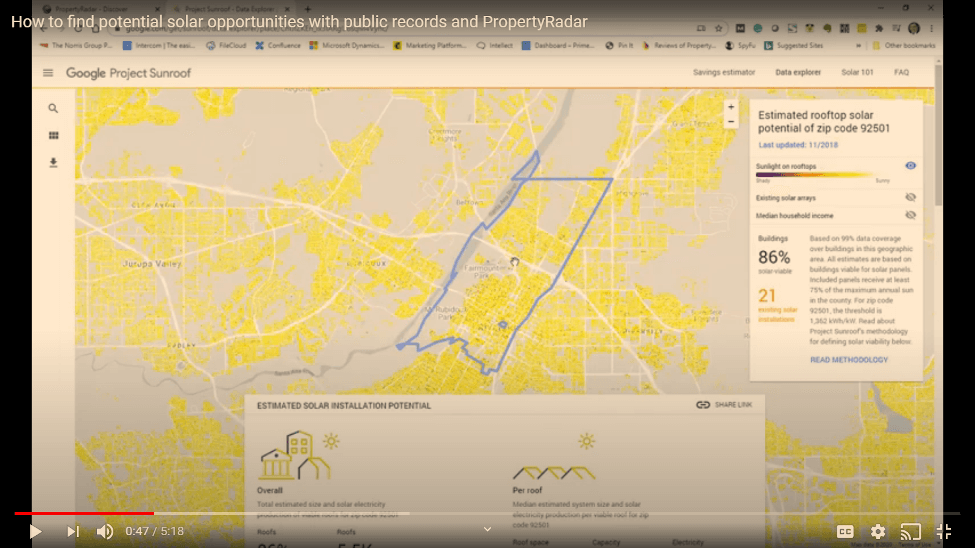
2. Of course, like much of California and other hopping solar markets, everything is sunny here! So that didn’t narrow prospects down by much. However, this step is useful for installers in emerging solar markets that don’t have such universally sunny climates.
To better qualify his list of solar prospects, Aaron then turned to PropertyRadar. Here, he searched for single-family, owner-occupied residences with high estimated property equity.
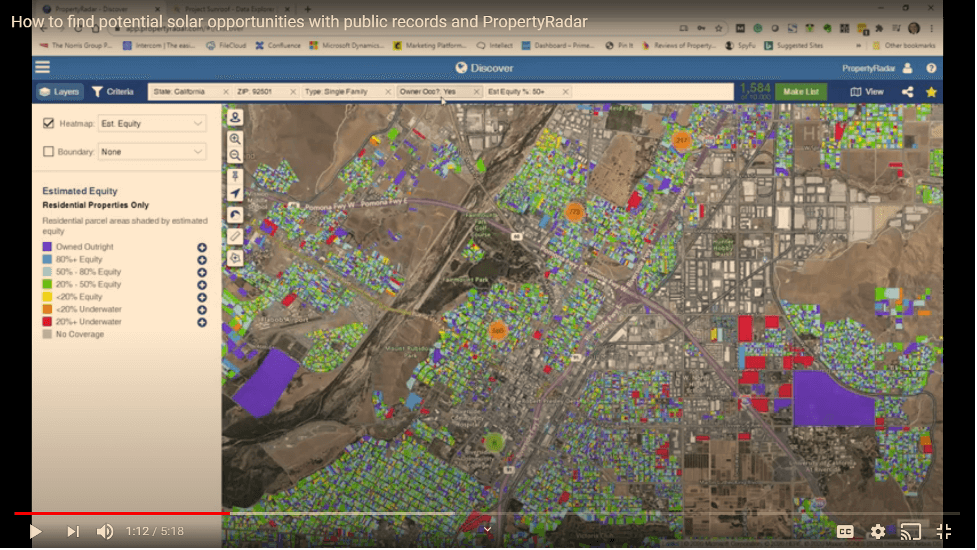
These filters immediately narrowed his leads down to about 1,600 opportunities in that particular zip code -- a much more manageable number!
3. Aaron then zoomed in on the heatmap of estimated equity to see how much equity individual households had -- a key piece of information for generating financially prepared solar leads.
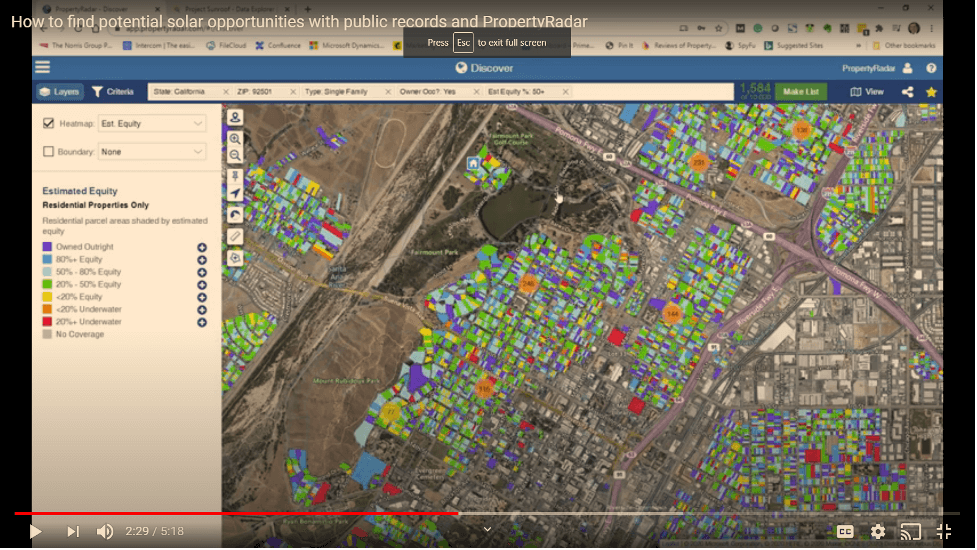
4. He then zoomed even further to see which houses might have too much shade for solar panels to be a good investment. For example, this neighborhood was recently built and has few mature trees, leaving roofs with plenty of sun exposure:
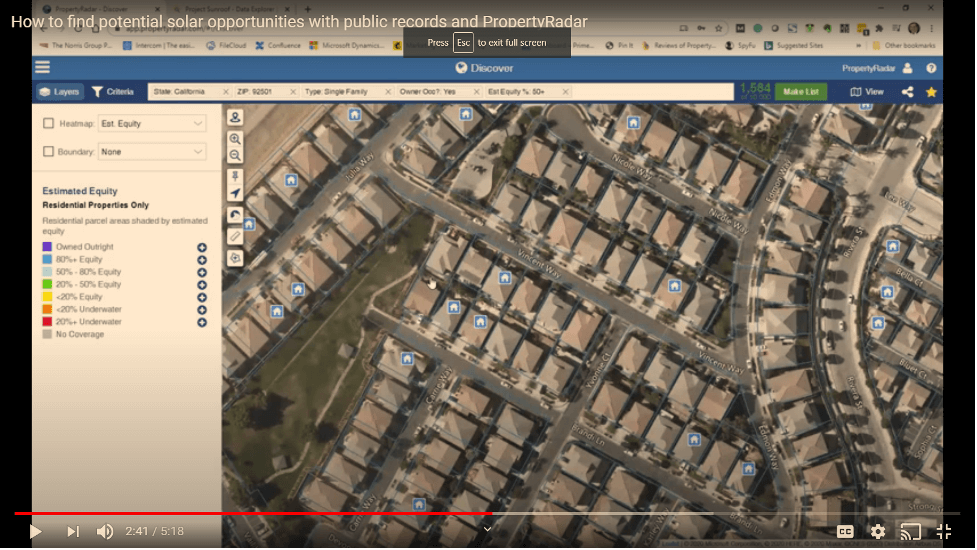
While in contrast, the towering trees of this century-old neighborhood make many of its households less effective targets for a solar mailing campaign:
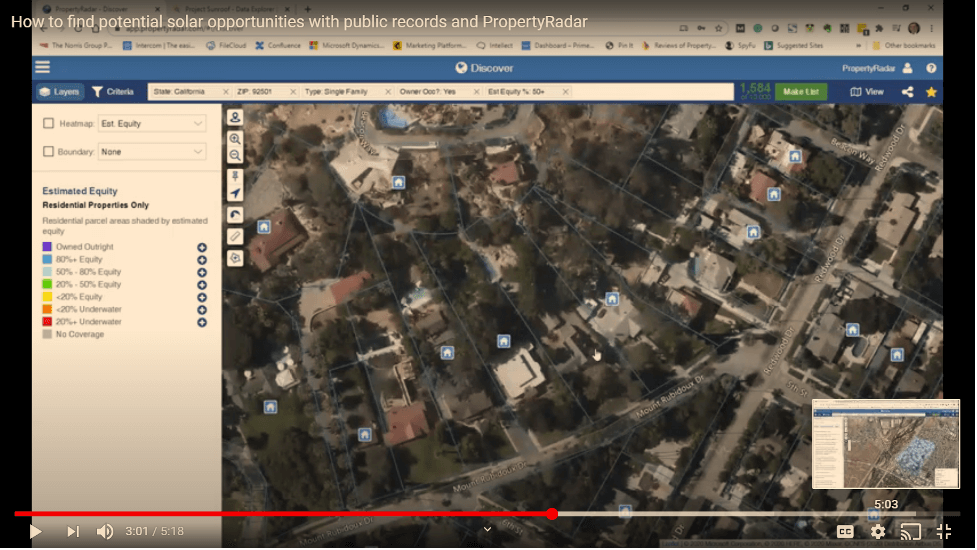
5. Aaron then shows you how to add individual houses to your solar lead list:
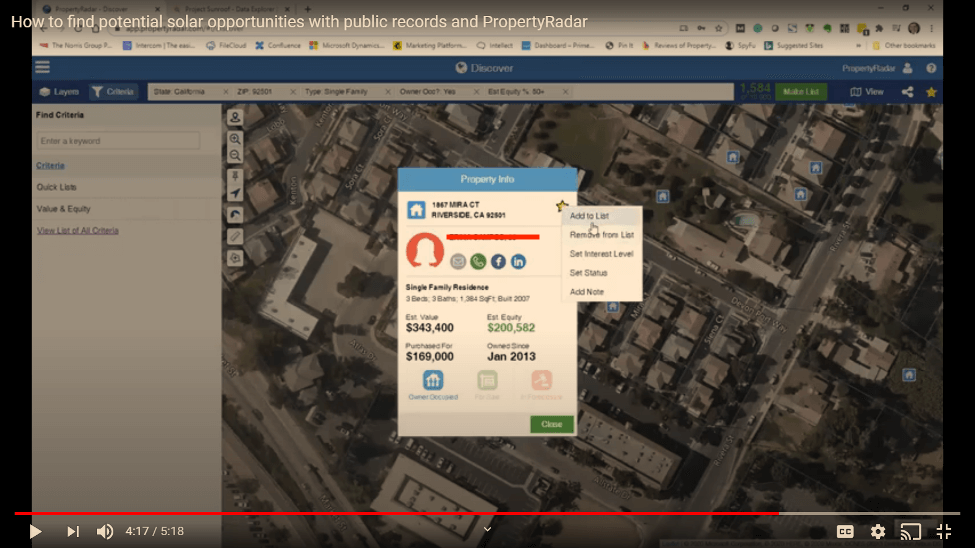
6. Lastly, Aaron shows us how to focus on a certain neighborhood or subsection by drawing your own unique area for that outreach.
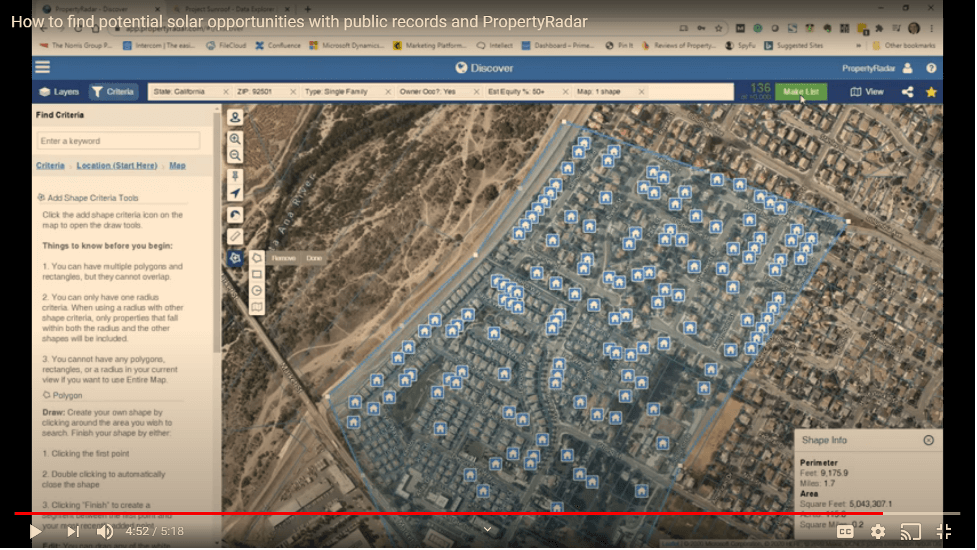
Following these steps creates a list of sunny-roofed, high-equity, owner-occupied households ready to find out about the benefits of going solar. It's a hyper-qualified solar leads list you can make for your area, for your team, right now when you start your free trial.
Qualifying Solar Leads Using Your Criteria
Ready for a more detailed guide to using PropertyRadar for a self-updating list of uniquely qualified leads? Here it is, from the very beginning:
Find Properties by Location (Start Here)
With an industry-leading 200+ criteria to find and qualify your leads, the most logical place to start is 'Location' of course:
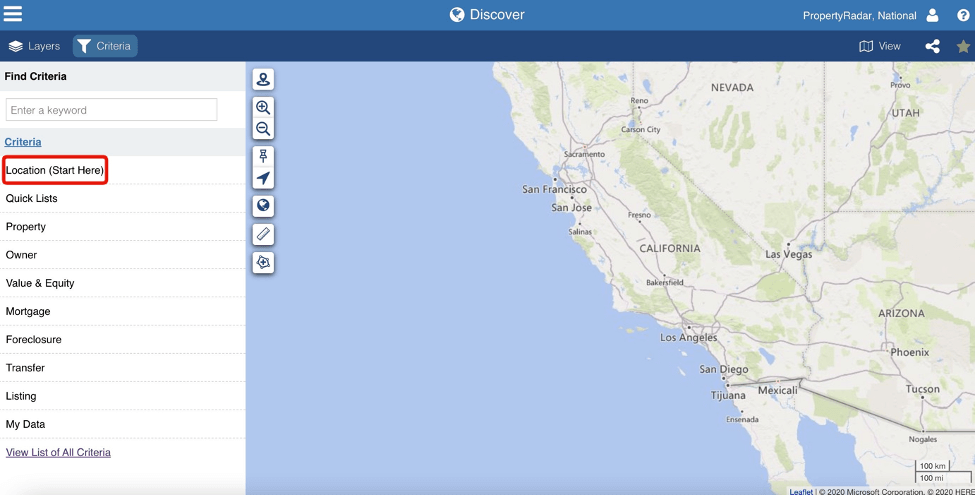
Once you click on Location, you will be asked to choose from 3 categories:
- Map (in which you use your tracker to draw a shape around your area of interest, as Aaron did in Step 6 above)
- Other (APN, Subdivision, Tax Rate Area, etc.)
- Address (the most common)
Clicking “Address” gives you numerous options:
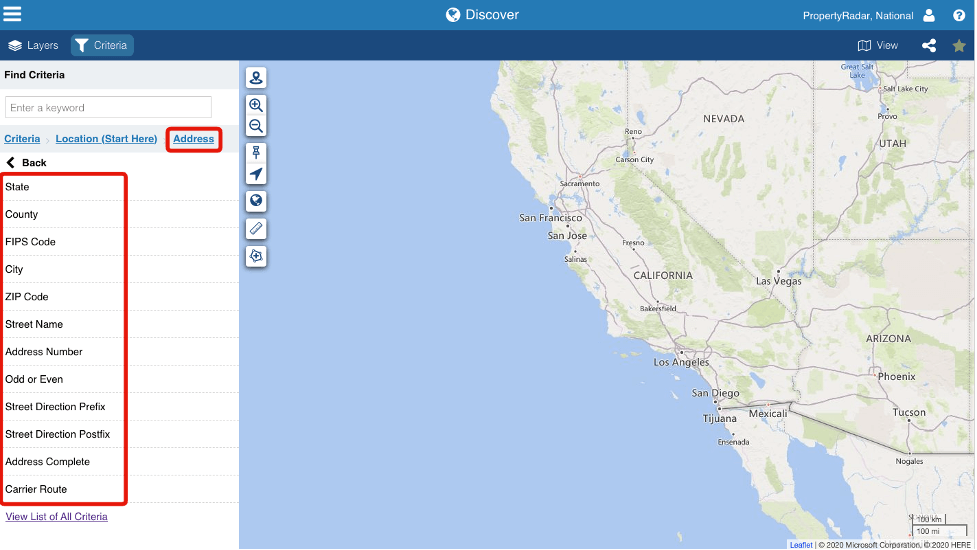
It’s easiest to just choose a zip code since that instantly selects the state and city/cities for you and automatically populates the area:
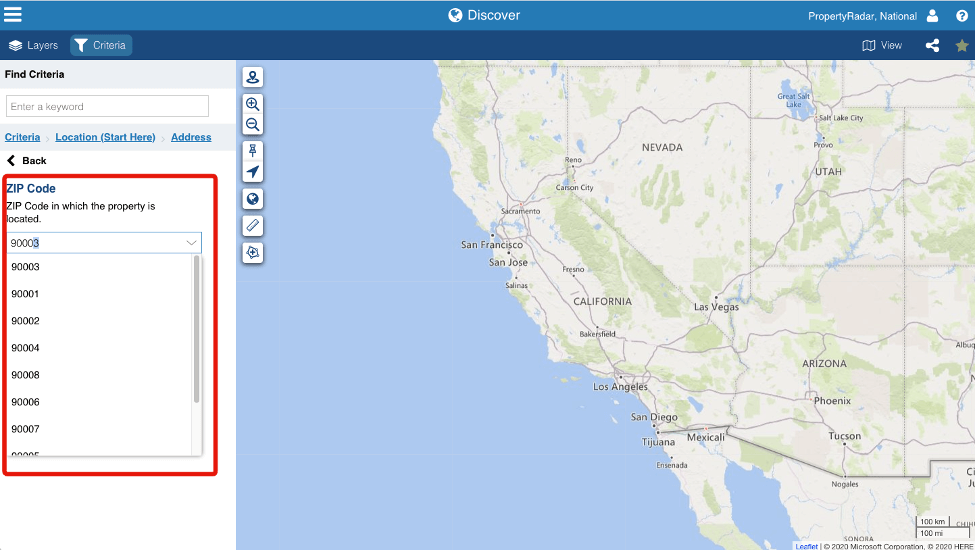
The below image shows the 8,661 properties found in Zip Code 90001:
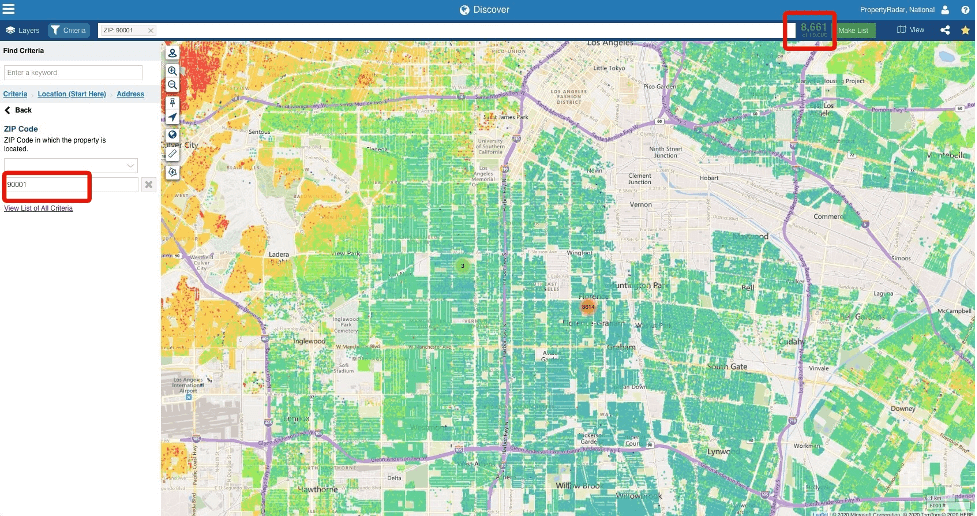
This image also shows a heatmap for the “relative value of residential properties.” Other heatmap options include property type, equity amount, ownership type, and more.
Find Properties By Property Type:
Selecting “Site” presents you with these options: Basic, Advanced, Lot Size (both square feet and acres), Zoning, and View Type.
We recommend beginning with “Basic”...
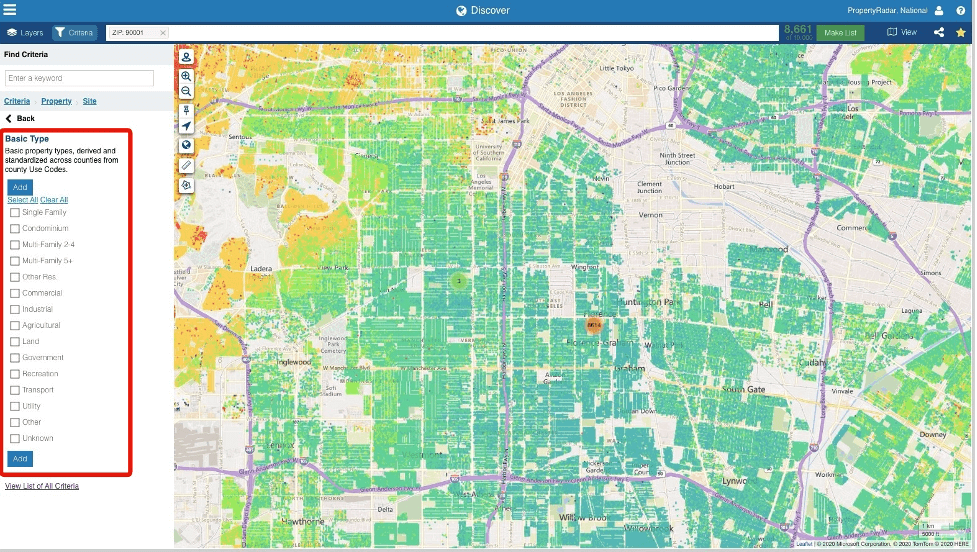
Selecting ‘Advanced Type’ breaks the Basic type properties down into literally dozens of ways...
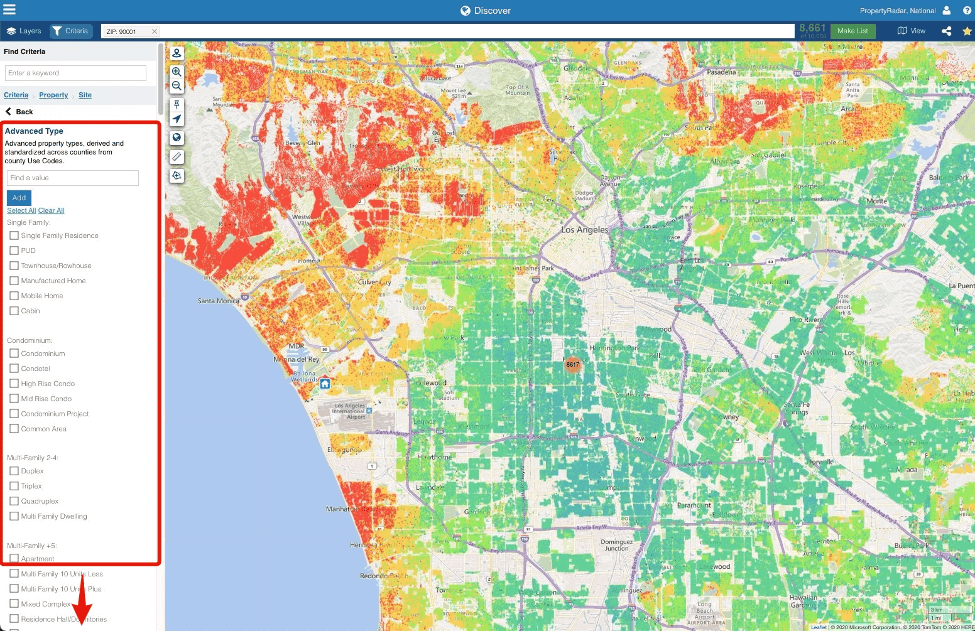
The 'Advanced Type' includes a criteria of particular interest to solar installers: roof type.
Below is a partial list of all the various roof types you can choose from:
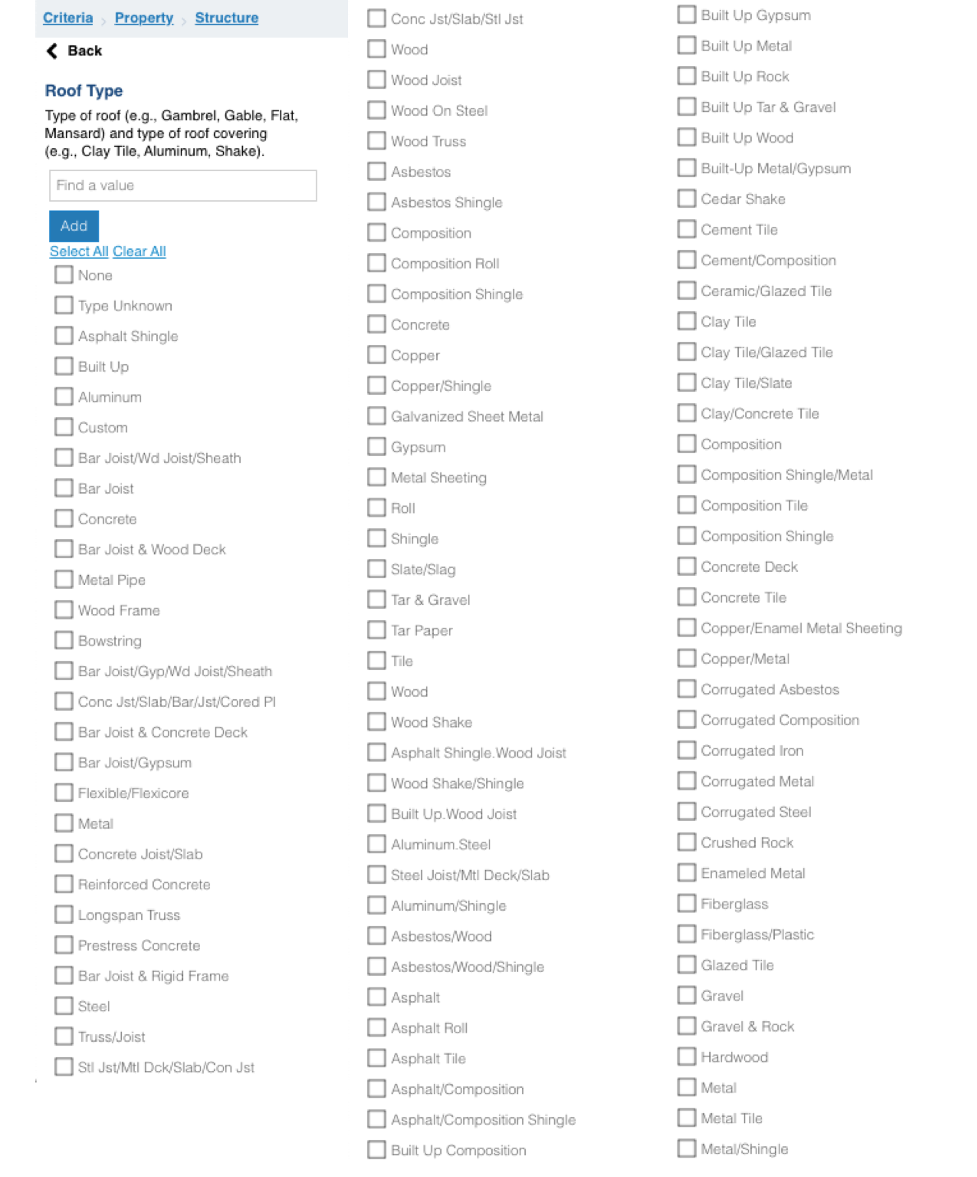
Moreover, many of the available criteria contain sub-criteria. This means you can get even more granular in your search for the perfect prospects using:
- Household Income
- Household Net Worth
- Property Value
- Current Equity
- Mortgage Loans
- Mailing Address
- Occupation Group
- Interests/Hobbies
- Age
- Marital Status
- Education Level
- Etc.
Now, what to do with all this information? Analyze and use it to build your business with the help of PropertyRadar’s insights:
Creating Lists of Targeted Solar Leads with Data-Driven Insights
As a motivated professional, you can’t waste time chasing any old property built before 2010 or that is simply over 2,000 sq/ft. You need to qualify leads before spending time and money marketing to them.
For instance, you likely want to know if a property is owner-occupied and if so, does the homeowner have the purchase power? Both are great criteria to add to qualify your leads. But before we get too far down the road, let's talk about PropertyRadar's Quick Lists.
Quick Lists are prebuilt-built marketing lists that have predefined criteria already built-in for you. So all you have to do is add your area of interest, and you’re good to go.
There are dozens of Quick Lists available to help you get started, with many created for home and property services professionals, like solar installers.
For example, our 'Recent Cash-Out Loans – Quick List' might be a great starting point for you. This list shows you all homeowners who’ve taken out an equity line of credit of $20,000+in the last 90 days.
PRO INSIGHT: Want to find homeowners who’ve cashed out in the last 30 days? No problem. All the tiles in your criteria bar are clickable. Click on the tile you want to modify and adjust accordingly.
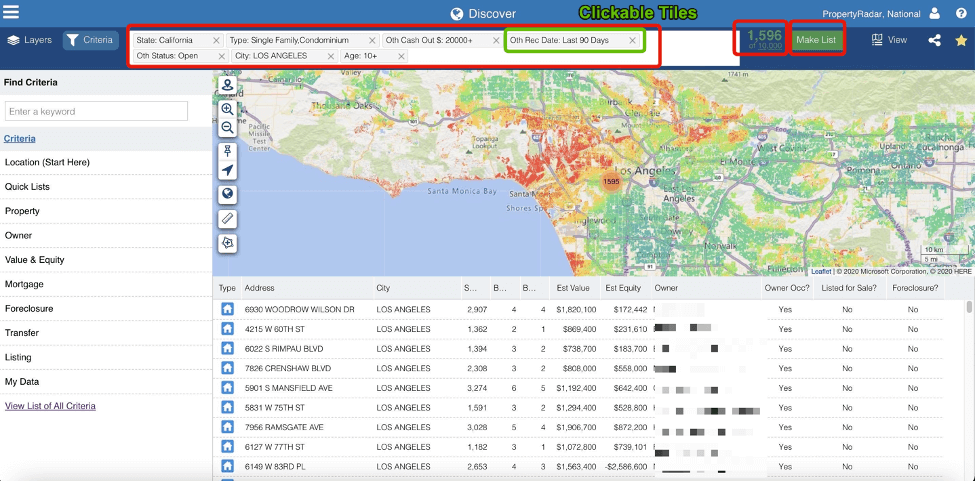
Above you find the results when we use the Quick List, Recent Cash Out Loans, and add the location criteria, Los Angeles City. Then we added structure age as a criteria: Property Structure, 10+ y/o.
We discover 1,596 properties that match this criteria. We can make this our Master List for this area by clicking the big green button ‘Make List’ and name it whatever we like.
Once you’ve built your master list, you can add additional criteria to segment it into smaller lists that are more refined. This gives you the ability to turn a list of solar leads who might be interested in your services into a list of solar leads who are highly likely to be interested and become solar sales.
Look at the “Overview of Property Owners” for Each List
PropertyRadar automatically generates helpful insights into every list. Click the ‘Insights’ tab to find both what your prospects have in common, and what makes each of them one-of-a-kind:
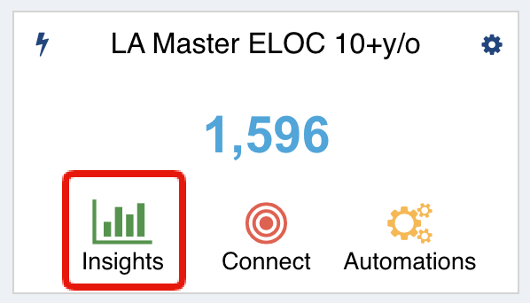
After you click insights, you’ll see obvious and not-so-obvious insights and knowledge about properties and property owners that you can’t get anywhere else.
List Insights - Property Owners
“Owner Insights” gives you an overview of your list and a visualization of:
- Owner Type
- Gender
- Age
- Education Level
- Marital Status
- Interests
- More
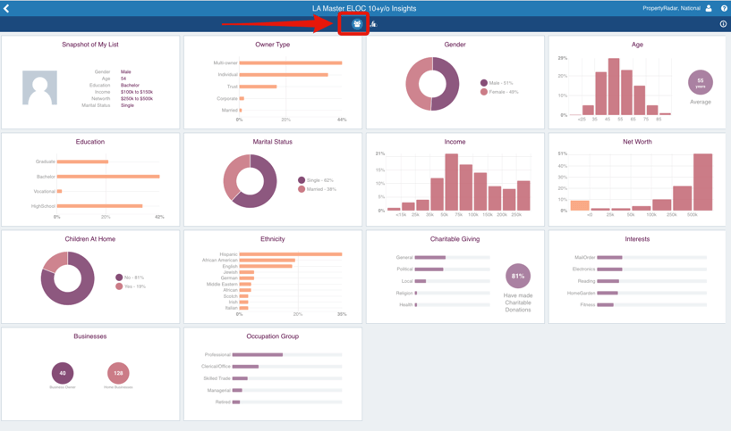
List Insights - Properties
“Property Insights” provides a snapshot overview and visualization of publicly available:
- Property type
- Owner-occupied or not
- Monthly transaction volume
- Estimated equity
- Assessed value
- Estimated tax rate
- More
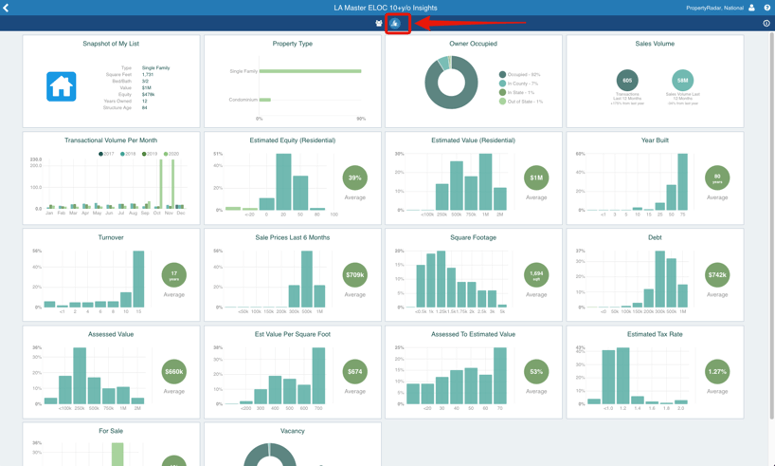
While these commonalities help your team create killer outreach campaigns, direct mail marketing is most effective when tailored to a prospect’s unique situation and needs. To find this data, click any property to discover details about it, the owner, its mortgage, its equity, the neighborhood, and more. This level of knowledge can give you the edge you need to convince the owner that they’re in good hands with you.
Reviewing Owner Details & Contact Information
Of course, you need your prospects’ contact information to show them you’re their best and most knowledgeable option for a solar installation. Click on the address bar below the map to get contact and property information. The ‘Contacts’ tab reveals owners’ publicly available age, gender, phone number, email, and social profiles.
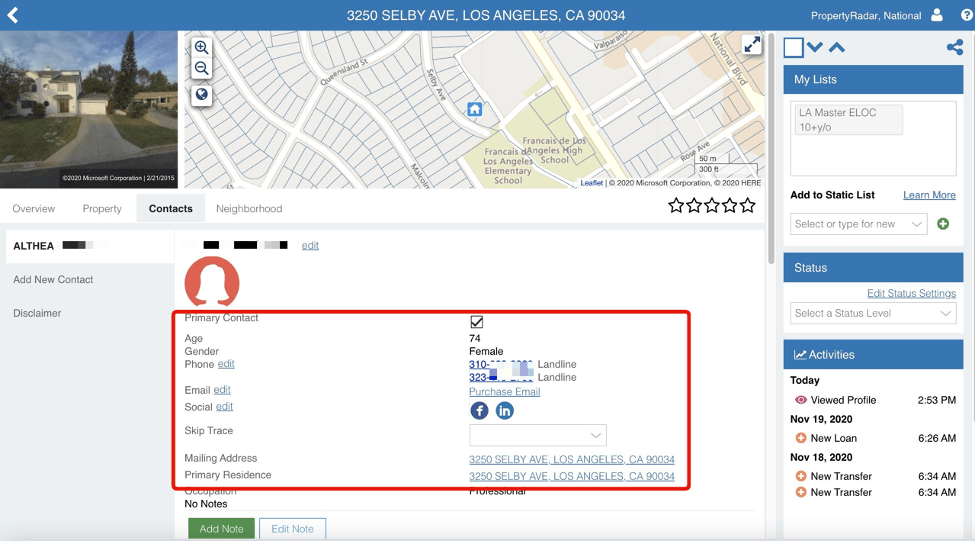
PropertyRadar includes a skip tracing option to help you find and connect with property owners.
Before seeing a property in person, you can save time by going to the street view of the property in the top left corner:
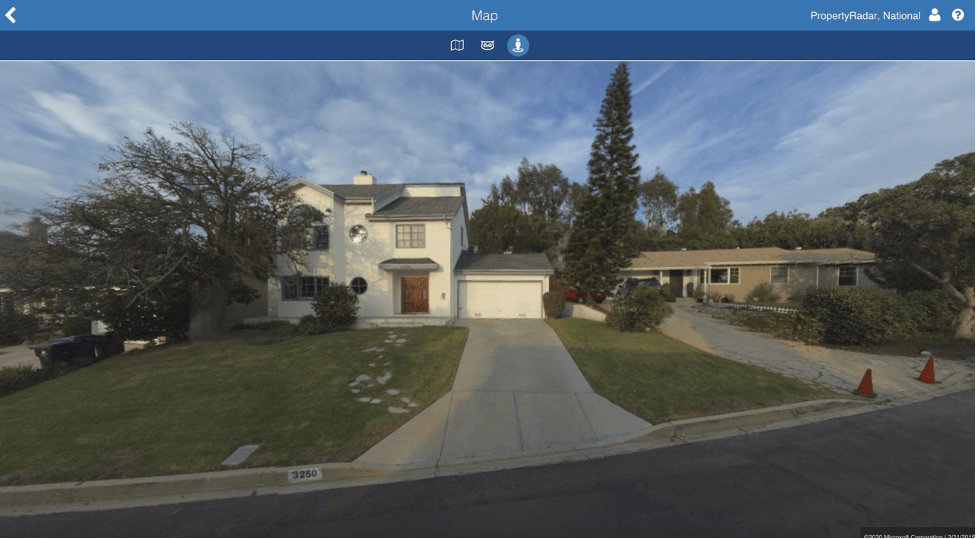
Switch to the Aerial Map View for that all-important closer look at the roof:
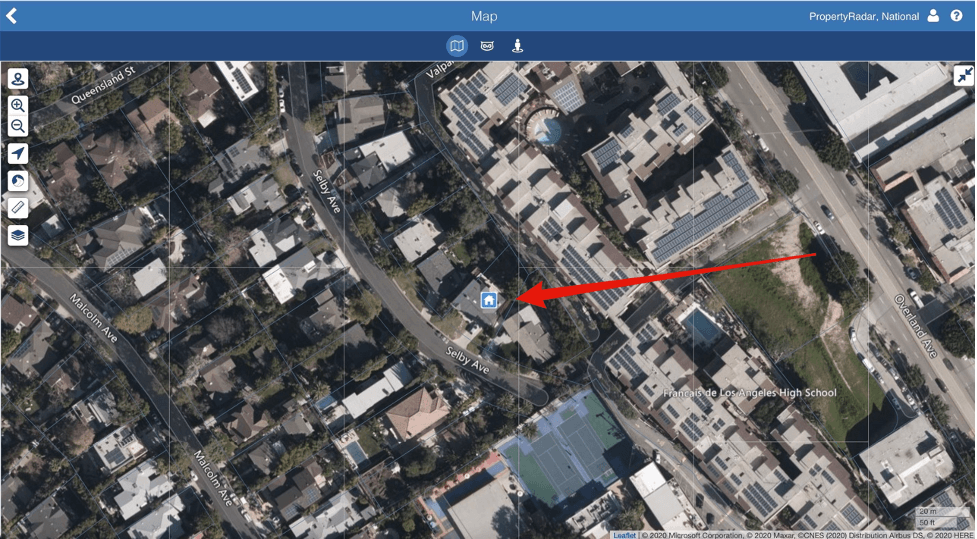
Reviewing Property, Mortgage, Equity Details
Click on the ‘Property’ tab to find essential decision-making information, including the amount of equity in the ‘Value’ section.
With this vast amount of granular data and so many ways to quickly filter, sort, and analyze it, a motivated solar installation team can save valuable time and money by targeting all -- and only --the most high-value solar leads in their area.
PropertyRadar Mobile App as Your Field Sales Software Tool
A truly comprehensive data platform’s usefulness doesn’t end with just giving you valuable information, essential though that is. The most useful data platforms enable team members to instantly add their own insights and information -- especially when they’re out in the field working, meeting prospects, and evaluating potential projects.
Such on-the-fly situations require solar professionals to capture and save images, notes, and other file types so that every piece of data can be integrated -- either in the moment or back at the office -- into a perfectly individualized marketing funnel. Learn more about how PropertyRadar's mobile app makes the perfect field sales software tool for solar installers here.
4 Ways to Turn Solar Leads Into Solar Sales with PropertyRadar
Now that you have your unique list of hot solar leads, it’s time to use it. With PropertyRadar, you can:
Autofill Your Pipeline with Unique Solar Leads
Once you’ve entered your parameters for lead lists, you don’t have to keep checking or paying a third-party source for new leads. PropertyRadar automatically adds any new leads that fulfill your requirements. You can even program PropertyRadar to reach out to each new lead with a direct mail welcome message mailer, email, or text -- all without taking up anytime on your team’s part.
Beat Your Competitors to New Opportunities
PropertyRadar’s continual updating of lists will bring the most qualified (by you) brand-new prospects to your attention. And unlike buying non-unique solar leads or third-party websites that provide quotes from multiple solar companies, it’ll do so without notifying your competitors as well.
Save Employees’ Time with Marketing Automation
Let’s face it: you either already automate some of your marketing processes, or you’re leaving money on the table. Just as automatically updated lead lists save time tracking down new leads, automated marketing processes take the boring “grunt work” away from your marketing team so that they can focus on the higher-level strategizing only humans can do.
Here’s our guide to creating an effective marketing automation stack for property service professionals (such as solar installers).
Follow Up on Leads with Multi-Touch Marketing
You probably wouldn't make a major financial decision such as going solar after seeing a single flyer, text, or email. Neither would most people.
Such leads take thoughtful, dedicated nurturing in the form of carefully messaged multi-channel touches. With the above-mentioned automated marketing stack, this essential step helps develop each lead’s unique relationship with your brand. See Solar Power World’s how to use retargeting to increase solar sales conversions for an industry-specific guide.
Generating Solar Leads for the Data-Driven Business with PropertyRadar
In conclusion, a robust property data tool like PropertyRadar helps your team do even more than make unique lists of high-quality solar leads. It helps your entire company keep up-to-date in the field, create both simple and complex marketing campaigns, and much more. With so much power to save time and money while increasing sales, the secret weapon of a property data platform is the foundation of any successful solar company’s marketing automation stack.
Looking For Solar Leads?
|



